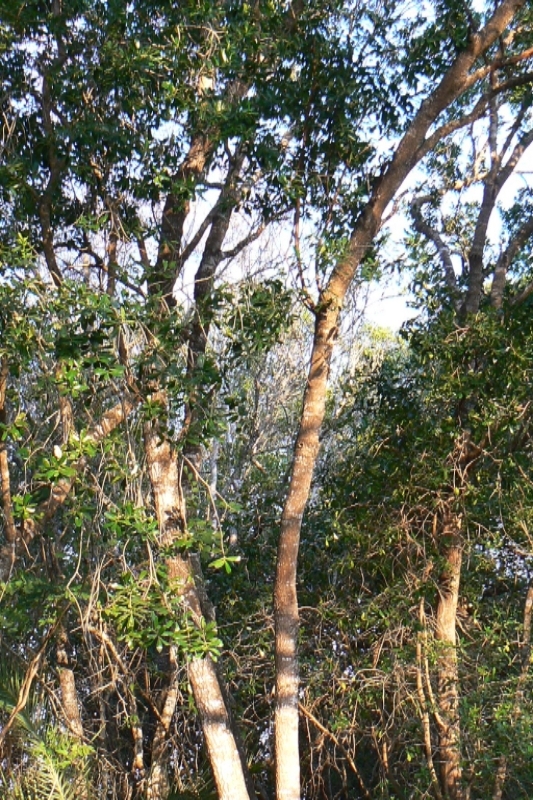Index to Trees & Shrubs in the Order Canellales
Family: Canellaceae
488. Warburgia salutaris Pepper Bark Tree https://africawild-forum.com/viewtopic.p ... 02#p301502
Africa Wild Tree & Shrub Book - Order Canellales
Moderator: Klipspringer
Re: Africa Wild Tree & Shrub Book - Order Canellales
488. Pepper Bark Tree Warburgia salutaris (Peperbasboom)
Order: Canellales. Family: Canellaceae



Tembe Elephant Park
Description
An aromatic evergreen tree, usually 5-10 m in height, but reaching 20 m in some areas, with a dense erect canopy. Bark smooth and grey on young branches but brown and slightly rough with prominent yellowish corky lenticels on older branches and stems; inner bark reddish, with a peppery smell.
Leaves aromatic, alternate, simple, elliptic to lanceolate, 4.5-11 x 1-3 cm, glossy dark green above, paler green and dull below; midrib frequently slightly off-centre; apex and base tapering; margin entire; petiole 1-3 mm long.
Flowers bisexual, up to 7 mm in diameter, solitary or in 3-flowered cymes in axils of leaves, green, 3 sepals, 10 petals, 5 inner petals smaller, thinner in texture and yellower than outer 5, filaments fused to form a prominent staminal tube.
Fruit oval berries, 4 cm in diameter, turning dark purple when ripe; skin leathery, glandular, black when mature. Containing 2 or more seeds with oily endosperm.
Distribution
The tree is known from only a few localities in the Northeastern parts of South Africa, Swaziland, South-eastern Zimbabwe and Southern Mozambique. It is also found in Malawi and Zambia.
Habitat
Occurs in savanna woodland, coastal forest and Afromontane forest.
Status
Endangered. There has been some habitat loss due to agricultural activities, expansion of human habitation and logging for firewood and timber. The major direct threat to the species is the exploitation of its bark, stems and roots for use in traditional medicinal practices as a treatment of head and chest ailments and also to cure people who are bewitched. This has led to the near extinction of the species in KwaZulu-Natal, parts of Mpumalanga, Swaziland and Zimbabwe.
Order: Canellales. Family: Canellaceae



Tembe Elephant Park
Description
An aromatic evergreen tree, usually 5-10 m in height, but reaching 20 m in some areas, with a dense erect canopy. Bark smooth and grey on young branches but brown and slightly rough with prominent yellowish corky lenticels on older branches and stems; inner bark reddish, with a peppery smell.
Leaves aromatic, alternate, simple, elliptic to lanceolate, 4.5-11 x 1-3 cm, glossy dark green above, paler green and dull below; midrib frequently slightly off-centre; apex and base tapering; margin entire; petiole 1-3 mm long.
Flowers bisexual, up to 7 mm in diameter, solitary or in 3-flowered cymes in axils of leaves, green, 3 sepals, 10 petals, 5 inner petals smaller, thinner in texture and yellower than outer 5, filaments fused to form a prominent staminal tube.
Fruit oval berries, 4 cm in diameter, turning dark purple when ripe; skin leathery, glandular, black when mature. Containing 2 or more seeds with oily endosperm.
Distribution
The tree is known from only a few localities in the Northeastern parts of South Africa, Swaziland, South-eastern Zimbabwe and Southern Mozambique. It is also found in Malawi and Zambia.
Habitat
Occurs in savanna woodland, coastal forest and Afromontane forest.
Status
Endangered. There has been some habitat loss due to agricultural activities, expansion of human habitation and logging for firewood and timber. The major direct threat to the species is the exploitation of its bark, stems and roots for use in traditional medicinal practices as a treatment of head and chest ailments and also to cure people who are bewitched. This has led to the near extinction of the species in KwaZulu-Natal, parts of Mpumalanga, Swaziland and Zimbabwe.


